


xxxxxThe Russian composer Nikolai Rimsky-Korsakov, a prominent leader of the Nationalist school, was a naval officer before making music his career. He met the Russian composer Mily Balakirev in 1861 and joined the circle of musicians which came to be known as The Mighty Five. This group, which included Modest Mussorgsky and Aleksandr Borodin, aimed to produce authentic Russian music. During the 1860s, with Balakirev’s guidance, he produced a number of successful works, including his symphonic poem Sadko, his Fantasy on Serbian Themes, and Antar, his second symphony. He became professor at the St. Petersburg Conservatory in 1871, and produced the first of his many operas in 1879. Based mainly on Slavonic fairy tales and legend, and full of exotic harmonies, these included May Night, The Snow Maiden, Christmas Eve, Sadko, The Tsar’s Bride, The Legend of Tsar Saltan, The Tale of the Invisible City of Kitezh, and, in 1907, The Golden Cockerel. Other works of note included his Spanish Capriccio, the symphonic suite Scheherazade of 1888, and the Russian Easter Festival Overture. He also wrote a quantity of chamber music, piano pieces and choral works, and more than eighty songs. His compositions were noted for their brilliant orchestration and their outstanding instrumentation. After Mussorgsky’s death, he edited his scores (notably his masterpiece Boris Godunov), and he also completed Borodin’s unfinished opera, Prince Igor. His textbook Fundamentals of Orchestration was published in 1913. Rimsky-Korsakov numbered among his friends the Russian composer Pyotr Tchaikovsky and, among his pupils, the budding composers Igor Stravinsky and Sergei Prokofiev.
NIKOLAI RIMSKY- KORSAKOV 1844 - 1908
(Va, Vb, Vc, E7)
Acknowledgements
Rimsky-Korsakov: detail, by the Russian painter Valentin Serov (1865-1911), 1898 – Tretyakov Gallery, Moscow. Tchaikovsky: by the German artist Charles Reutlinger (1816-c1890), c1875. Nadezhda: detail, by the German painter Franz Xavier Winterhalter (1805-1873), 1864 – Musée d’Orsay, Paris. Balakirev: by the Russian artist Nikolai Petrovich Meshchaninov (1913-1967) – Glinka Museum of Music, Moscow. Mighty Five: dates and artists unknown. Borodin: 1865, photographer unknown. Franck: by the French artist Pierre Petit (1829-1909) – Haags Gemeentemuseum, The Hague, The Netherlands.
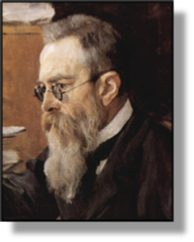 xxxxxNikolai Rimsky-Korsakov, one of Russia’s leading composers of the Nationalist School, was born at Tikhvin near Novgorod, the son of wealthy, aristocratic parents, both of whom were amateur musicians. He studied piano as a child and began composing short pieces by the age of ten, but inspired by his uncle, an admiral in the Russian navy, and by his elder brother, also serving in the navy, he was keen to go to sea. When, at the age of 12, the family moved to St. Petersburg, he became a cadet at the Imperial Naval Academy there and began a career which, over the next thirty years, was to take him all over the world. His love of the sea and of water in general is portrayed in many of his symphonic works, such as Sadko and Scheherazade, and in operas like The Tale of Tsar Saltan and The Legend of the Invisible City of Kitezh.
xxxxxNikolai Rimsky-Korsakov, one of Russia’s leading composers of the Nationalist School, was born at Tikhvin near Novgorod, the son of wealthy, aristocratic parents, both of whom were amateur musicians. He studied piano as a child and began composing short pieces by the age of ten, but inspired by his uncle, an admiral in the Russian navy, and by his elder brother, also serving in the navy, he was keen to go to sea. When, at the age of 12, the family moved to St. Petersburg, he became a cadet at the Imperial Naval Academy there and began a career which, over the next thirty years, was to take him all over the world. His love of the sea and of water in general is portrayed in many of his symphonic works, such as Sadko and Scheherazade, and in operas like The Tale of Tsar Saltan and The Legend of the Invisible City of Kitezh.
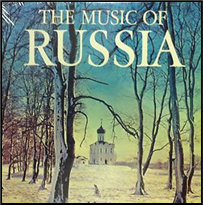 xxxxxHowever, despite his naval duties, Rimsky-Korsakov continued his musical studies, keen to make his name as a composer. He continued taking lessons in piano and composition, and in November 1861 he met the Russian composer Mily Balakirev. Under his guidance he joined The Mighty Five, a group of young, amateur composers which included Modest Mussorgsky and Aleksandr Borodin, and had as its aim the production of authentic Russian music, devoid of Western influences. And it was at this time, greatly assisted by Balakirev, that he began composing in earnest. During the 1860s he produced a number of successful works including his first Symphony in E Flat Minor, performed at Balakirev’s Free School of Music in St. Petersburg, his symphonic poem entitled Sadko (later adapted as an opera), his Fantasy on Serbian Themes, and Antar, his second Symphony, later revised as an Oriental Suite.
xxxxxHowever, despite his naval duties, Rimsky-Korsakov continued his musical studies, keen to make his name as a composer. He continued taking lessons in piano and composition, and in November 1861 he met the Russian composer Mily Balakirev. Under his guidance he joined The Mighty Five, a group of young, amateur composers which included Modest Mussorgsky and Aleksandr Borodin, and had as its aim the production of authentic Russian music, devoid of Western influences. And it was at this time, greatly assisted by Balakirev, that he began composing in earnest. During the 1860s he produced a number of successful works including his first Symphony in E Flat Minor, performed at Balakirev’s Free School of Music in St. Petersburg, his symphonic poem entitled Sadko (later adapted as an opera), his Fantasy on Serbian Themes, and Antar, his second Symphony, later revised as an Oriental Suite.
xxxxxSuch was his reputation as a composer that in 1871, at the age of 27, he was appointed professor of practical composition and instrumentation at the St. Petersburg Conservatory (now named the Rimsky-Korsakov State Conservatory), a post he held for the rest of his life. He later confessed in his autobiography, Chronicle of My Musical Life, that, as he had never taken a academic course in musical theory, he struggled during the first few years of his appointment, just managing to keep one lesson ahead of his students. However, he left the navy in 1873 and two years later, after a rigorous programme of self-tuition, he had completed his own musical education and become confident and proficient in both his teaching and conducting. His defection to the musical establishment was seen as a betrayal by the other members of The Five, but in fact, over the coming years his compositions were to hold firm to the movement’s aims and beliefs.
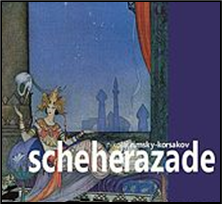 xxxxxIn the 1870s he composed some notable chamber music, such as his String Quartet, String Sextet and his Quintet for Piano and Winds, and the 1880s saw a number of dazzling works which have remained popular, including his Spanish Capriccio, the symphonic suite Scheherazade of 1888, (inspired by a tale from The Arabian Nights), and the Russian Easter Festival Overture, based on ancient liturgical chants of the Russian Orthodox Church. But, it was in his series of operas, beginning with May Night in 1879, that
xxxxxIn the 1870s he composed some notable chamber music, such as his String Quartet, String Sextet and his Quintet for Piano and Winds, and the 1880s saw a number of dazzling works which have remained popular, including his Spanish Capriccio, the symphonic suite Scheherazade of 1888, (inspired by a tale from The Arabian Nights), and the Russian Easter Festival Overture, based on ancient liturgical chants of the Russian Orthodox Church. But, it was in his series of operas, beginning with May Night in 1879, that 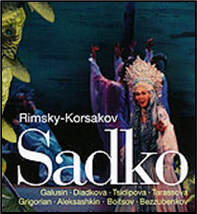 Rimsky-Korsakov captured above all the music and the spirit of his native Russia. Taken mainly from Slavonic fairy tales and legend, and full of exotic harmonies, these productions included The Snow Maiden of 1881, Mlada, Christmas Eve, Sadko and The Tsar’s Bride in the 1890s, and, in the opening years of the new century, The Legend of Tsar Saltan (which includes the famous Flight of the Bumblebee), The Tale of the Invisible City of Kitezh, and The Golden Cockerel, a satirical attack upon despotism that fell foul of the censor and was banned for two years.
Rimsky-Korsakov captured above all the music and the spirit of his native Russia. Taken mainly from Slavonic fairy tales and legend, and full of exotic harmonies, these productions included The Snow Maiden of 1881, Mlada, Christmas Eve, Sadko and The Tsar’s Bride in the 1890s, and, in the opening years of the new century, The Legend of Tsar Saltan (which includes the famous Flight of the Bumblebee), The Tale of the Invisible City of Kitezh, and The Golden Cockerel, a satirical attack upon despotism that fell foul of the censor and was banned for two years.
xxxxxThroughout his career Rimsky-Korsakov played an active part in the musical life of the city of St. Petersburg. He was director and conductor of the Free Music School from 1874 - the year he conducted his first performance of his Third Symphony - and he remained in this post until 1881. He then served as chief conductor of the Russian Symphony Concerts from 1886 to 1900, during which time he led the performances of Russian music at the Paris World Exposition in 1889. Because of his left-wing sympathies, he was sacked from the Conservatory in 1905 (the year of the First Russian 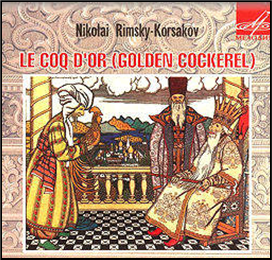 Revolution), but two years later he produced his final opera, The Golden Cockerel, and visited Paris to conduct concerts for the Ballet Russes, a company formed and directed by the Russian ballet impresario Sergei Diaghilev. The following year, 1908, he suffered a fatal heart attack and died at his estate near Luga (now Plyusski). He was interred at the Tikhvin Cemetery in St. Petersburg, near to the graves of Borodin, Mussorgsky, and Glinka. His death brought an end to the great era of Russian music, but a new, exciting age emerged two years later when the controversial ballet Firebird, the work of the Russian revolutionary composer Igor Stravinsky, was given its first performance.
Revolution), but two years later he produced his final opera, The Golden Cockerel, and visited Paris to conduct concerts for the Ballet Russes, a company formed and directed by the Russian ballet impresario Sergei Diaghilev. The following year, 1908, he suffered a fatal heart attack and died at his estate near Luga (now Plyusski). He was interred at the Tikhvin Cemetery in St. Petersburg, near to the graves of Borodin, Mussorgsky, and Glinka. His death brought an end to the great era of Russian music, but a new, exciting age emerged two years later when the controversial ballet Firebird, the work of the Russian revolutionary composer Igor Stravinsky, was given its first performance.
xxxxxRimsky-Korsakov was the most industrious and the most successful of The Mighty Five. He excelled in the field of opera, but all his works were noted for their richness of orchestration and their outstanding instrumentation. They did not show the originality associated with Mussorgsky, nor the depth achieved by Borodin, but they were full of glittering sound and exotic imagery, conjuring up the folk tunes and the harmonic system of Russia’s own musical heritage. His music, brilliantly scored and always fired with imagination, created a world splashed with colour, and made him, in the words of the Russian composer Sergei Rachmaninov “a great master of orchestral sound painting”. Apart from his operas and orchestral works, he wrote a quantity of chamber music, some piano pieces and choral works, and more than eighty songs, mostly written in sets of four and noted for their elegance. Early on he took as his models the works of the Russian composer Mikhail Glinka and the Hungarian composer Franz Liszt, but his orchestration was later influenced by that of the German composer Richard Wagner.
xxxxxAnd apart from his own variety of compositions, Rimsky-Korsakov served Russian music well by editing the works of other Russian composers. After Mussorgsky’s death, for example, he edited his scores, making alterations where he saw fit. He practically rewrote his opera Khovanshchina, and made extensive changes to his masterpiece Boris Godunov. In addition, working with the Russian composer Alexander Glazunov, he edited the posthumous works of Borodin and completed his opera Prince Igor. During his career he wrote two highly influential books, A Practical Manual of Harmony, produced in 1884, and Fundamentals of Orchestration, published posthumously in 1913.
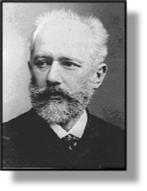 xxxxxWithin the members of The Mighty Five, Rimsky-Korsakov was a particularly close friend of Mussorgsky and Borodin. He shared a flat with Mussorgsky until his marriage in 1872, and for much of his career he was encouraged and guided in his work by his fellow countryman and composer Pyotr Tchaikovsky (illustrated). Among his students were the budding young composers Igor Stravinsky and Sergei Prokofiev. He was particularly involved in the training of Stravinsky, and was influential in having his music performed at an early stage.
xxxxxWithin the members of The Mighty Five, Rimsky-Korsakov was a particularly close friend of Mussorgsky and Borodin. He shared a flat with Mussorgsky until his marriage in 1872, and for much of his career he was encouraged and guided in his work by his fellow countryman and composer Pyotr Tchaikovsky (illustrated). Among his students were the budding young composers Igor Stravinsky and Sergei Prokofiev. He was particularly involved in the training of Stravinsky, and was influential in having his music performed at an early stage.
xxxxxIncidentally, on leaving the navy in 1873, Rimsky-Korsakov was appointed the Inspector of Naval Bands. In this capacity he travelled throughout Russia, improving his knowledge of wind and brass instruments and proving highly successful in training inexperienced instrumentalists. The knowledge he gained in this appointment greatly assisted him in the scoring of his own compositions. ……
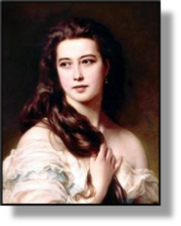 Xxxxx…… Nadezhda, whom Rimsky-Korsakov married in July 1872, was an accomplished pianist who, at the time of their marriage, was far better trained musically than her husband. A beautiful and capable woman, she supported her husband throughout his career, attending rehearsals, suggesting improvements to his works, and for ever extolling his virtues as a composer. It is said that on the day of their marriage they read together May Night, the short story by the Russian novelist Nikolai Gogol. A few years later this work formed the basis of Rimsky-Korsakov’s first opera. The couple had seven children. ……
Xxxxx…… Nadezhda, whom Rimsky-Korsakov married in July 1872, was an accomplished pianist who, at the time of their marriage, was far better trained musically than her husband. A beautiful and capable woman, she supported her husband throughout his career, attending rehearsals, suggesting improvements to his works, and for ever extolling his virtues as a composer. It is said that on the day of their marriage they read together May Night, the short story by the Russian novelist Nikolai Gogol. A few years later this work formed the basis of Rimsky-Korsakov’s first opera. The couple had seven children. ……
Xxxxx…… In his Foundations of Orchestration Rimsky-Korsakov advanced the theory that the four basic woodwinds possessed a vast range of expression, and should be used to a greater extent. This idea had a profound effect upon the music of the early 20th century, including the dance bands which became so popular in America during the 1930s. ……
xxxxx…… On hearing Rimsky-Korsakov’s orchestral piece Spanish Capriccio, Tchaikovsky wrote that it was a “masterpiece of instrumentation, and made him “the greatest master of the day”!
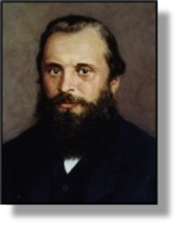 xxxxxThexRussian pianist, composer and conductor Mily Balakirev (1837-1910) wrote two symphonies (1897 and 1908), and a symphonic poem entitled Tamara in 1883 (which he dedicated to Franz Liszt). Also notable among his works was the fiery oriental fantasy Islamey, composed for solo piano in 1869. These and his other compositions, by their mixture of sweet melody and splashes of passion and fantasy, conjured up the countryside and the colourful history and folk legend of Mother Russia. Today, however, he is mostly remembered as the man who, in 1862, set up and firmly led The Mighty Five, a small circle of amateur composers aimed at promoting Russian musi
xxxxxThexRussian pianist, composer and conductor Mily Balakirev (1837-1910) wrote two symphonies (1897 and 1908), and a symphonic poem entitled Tamara in 1883 (which he dedicated to Franz Liszt). Also notable among his works was the fiery oriental fantasy Islamey, composed for solo piano in 1869. These and his other compositions, by their mixture of sweet melody and splashes of passion and fantasy, conjured up the countryside and the colourful history and folk legend of Mother Russia. Today, however, he is mostly remembered as the man who, in 1862, set up and firmly led The Mighty Five, a small circle of amateur composers aimed at promoting Russian musi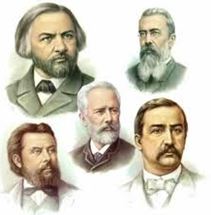 c. He and his fellowxmusicians were (clockwise from left) Balakirev, Rimsky-Korsakov, Borodin, and Mussorgsky, with (centre) César Cui, an army officer who composed and worked as a music critic in his spare time. They acquired their name in 1867 following the first performance of Rimsky-Korsakov’s Fantasy on Serbian Themes. Onxhearing the work, the Russian music critic Vladimir Stasov (1824-1906) announced that Russia now had its own “mighty little heap” of native composers. The idea caught on and the group took its place in music history under a variety of titles, including The Mighty Five, The Russian Five and The Mighty Handful.
c. He and his fellowxmusicians were (clockwise from left) Balakirev, Rimsky-Korsakov, Borodin, and Mussorgsky, with (centre) César Cui, an army officer who composed and worked as a music critic in his spare time. They acquired their name in 1867 following the first performance of Rimsky-Korsakov’s Fantasy on Serbian Themes. Onxhearing the work, the Russian music critic Vladimir Stasov (1824-1906) announced that Russia now had its own “mighty little heap” of native composers. The idea caught on and the group took its place in music history under a variety of titles, including The Mighty Five, The Russian Five and The Mighty Handful.
xxxxxBalakirev studied mathematics at the University of Kazan, but it was then that he began his musical career. In 1855 he met and was inspired by the Russian composer Mikhail Glinka - the “Father of Russian Music” - and three years later he played the piano in the presence of the Tsar. He assisted in the foundation of the Free School of Music in St. Petersburg in 1862, and it was then that he set up and became the driving force of The Mighty Five. He was appointed director of the Imperial Court Chapel in 1883, but retired in 1894 to concentrate on his composition.
Vc-1881-1901-Vc-1881-1901-Vc-1881-1901-Vc-1881-1901-Vc-1881-1901-Vc-1881-1901-Vc
xxxxxWorthy of mention at this time is the French pianist, organist, teacher and composer César Franck (1822-1890). He spent most of his life in Paris, making his living as a teacher and organist and composing, in addition to piano and organ works, orchestral, chamber and vocal music. He played the organ for a number of major churches in the city, including Sainte Clotilde from 1858, and gained a reputation for his ability both as an organist and a teacher. In 1872 he was appointed professor of organ at the Paris Conservatoire, and it was from then that he composed his major works. These included his oratorios Redemption and Les Béatitudes, his Piano Quintet, his Symphonic Variations, his Violin Sonata, his Prélude, Choral and Fugue for piano, and his massive Symphony of 1888. He is especially remembered today for Panis Angelicus, a communion anthem which he put to music in 1872. His music was mostly meditative in mood, and particularly noted for its use of chromatic harmonies and the skilful use of counterpoint. Liszt gave him advice and promoted his works, and he knew, amongst others, the French composers Delibes, Saint Saëns and Fauré.
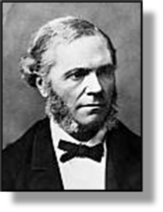 xxxxxAnd worthy of mention at this time is the French pianist, organist, teacher and composer César Franck (1822-1890). Though he achieved little fame or fortune during his lifetime, he is remembered today for his orchestral, chamber and vocal music, as well as for his brilliant compositions for piano and organ.
xxxxxAnd worthy of mention at this time is the French pianist, organist, teacher and composer César Franck (1822-1890). Though he achieved little fame or fortune during his lifetime, he is remembered today for his orchestral, chamber and vocal music, as well as for his brilliant compositions for piano and organ.
xxxxxFranck was born in Liège, Belgium, and showed musical talent at an early age. He attended the city’s Royal Conservatoire at the age of eight and, under the strict guidance of his father - who had ambitions of his becoming a concert pianist - was touring Belgium as a piano virtuoso some three years later. To further his career the family then moved to Paris, and from 1837 he spent five years studying piano and organ at the Paris Conservatoire. He did well throughout the course, winning prizes for piano, fugue and organ, and showing a remarkable ability at sight reading. However, on his return to Belgium in 1842 his early compositions, notably his oratorio Ruth, made little if any impression. Disillusioned and having no desire to become a piano virtuoso, despite his father’s wishes, he returned to Paris in 1844 bent on pursuing his own career.
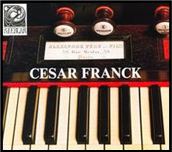
xxxxxLife in the French capital was to his liking. He continued to compose, made a living giving piano lessons, and played the organ at several major churches in the city, including Notre Dame de Lorette and, from 1858 onwards, the Basilica of Sainte Clotilde, a church noted for its exquisite organ. As a well-respected teacher he entered fully into the city’s musical life, and, as a highly talented organist, he gained a growing reputation as a brilliant improviser. His compositions over the next ten years or so were mainly organ pieces and church music, and such was the growing strength of his reputation that in 1872 he was appointed professor of organ at the Paris Conservatoire. There, widening his scope as a composer, he became a champion of instrumental music and attracted a number of ardent devotees among his many students. Sadly, however, his career, was cut short. In 1890 he was badly hurt in a road accident, and although he appeared to make a successful recovery, he was suddenly taken ill and died later that year. He was buried in Montparnasse Cemetery, and among those who attended the funeral were the French composers Delibes, Saint Saëns and Fauré.
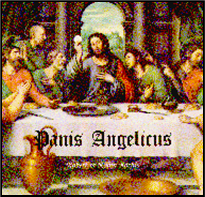 xxxxxFranck composed only twelve major organ works during his career, produced over a period of thirty years, but such were their quality that he is recognised today as one of the greatest composers of organ music since the German composer Johann Sebastian Bach. His major symphonic, chamber and keyboard works date from the late 1870s and the 1880s. They include his oratorios Redemption and Les Béatitudes, his Piano Quintet, his tone poem Le Chasseur Maudit, his Symphonic Variations, his Violin Sonata, his well-known Prélude, Choral and Fugue for piano, and his massive Symphony in D minor, completed in 1888. His beautiful Panis Angelicus, a sacred song and communion anthem which he put to music in 1872, remains his most popular piece. His compositions, noted for their chromatic harmonies and skilful use of counterpoint, were mostly meditative in mood, and at times owed something to the works of Liszt and Wagner.
xxxxxFranck composed only twelve major organ works during his career, produced over a period of thirty years, but such were their quality that he is recognised today as one of the greatest composers of organ music since the German composer Johann Sebastian Bach. His major symphonic, chamber and keyboard works date from the late 1870s and the 1880s. They include his oratorios Redemption and Les Béatitudes, his Piano Quintet, his tone poem Le Chasseur Maudit, his Symphonic Variations, his Violin Sonata, his well-known Prélude, Choral and Fugue for piano, and his massive Symphony in D minor, completed in 1888. His beautiful Panis Angelicus, a sacred song and communion anthem which he put to music in 1872, remains his most popular piece. His compositions, noted for their chromatic harmonies and skilful use of counterpoint, were mostly meditative in mood, and at times owed something to the works of Liszt and Wagner.
xxxxxIncidentally, the composers Liszt and Meyerbeer listened to some of Franck’s early works, and saw some merit in them. Liszt, a man noted for the help he gave to up-and-coming composers, spent some time in offering advice and promoting his works. Meanwhile the German conductor Hans von Bulow regularly included some of Franck’s pieces in concerts being held in Germany. ……
xxxxx…… In February 1848 Franck married Félicité Saillot, one of his former piano pupils. 1848 being The Year of Revolutions - during which time the major cities of Europe, and especially Paris, were centres of rebellion - they had to climb over the street barricades, assisted by the insurgents, to get to the church!
Including:
Mily Balakirev,
Aleksandr Borodin
and César Franck

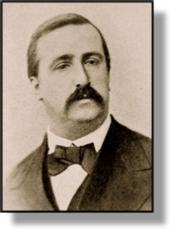 xxxxxAs we have seen, the Russian composer Aleksandr Borodin (1833-1887) was a member of the Mighty Five and a particularly close friend of Nikolai Rimsky-Korsakov. They often worked together, experimenting with different orchestral instruments. Although Borodin only wrote music in his spare time - he worked in medical chemistry for most of his life - his small number of works had an impact on Russian music and gained him a reputation beyond his homeland. Hisxcompositions included symphonies, chamber music and songs, but his principal work was the opera Prince Igor, left unfinished at his death and completed, as we have seen, by Rimsky-Korsakov and the Russian composer Alexander Glazunov (1865-1936) in 1888.
xxxxxAs we have seen, the Russian composer Aleksandr Borodin (1833-1887) was a member of the Mighty Five and a particularly close friend of Nikolai Rimsky-Korsakov. They often worked together, experimenting with different orchestral instruments. Although Borodin only wrote music in his spare time - he worked in medical chemistry for most of his life - his small number of works had an impact on Russian music and gained him a reputation beyond his homeland. Hisxcompositions included symphonies, chamber music and songs, but his principal work was the opera Prince Igor, left unfinished at his death and completed, as we have seen, by Rimsky-Korsakov and the Russian composer Alexander Glazunov (1865-1936) in 1888.
xxxxxBorn in St. Petersburg, Borodin was the illegitimate son of a Georgian prince named Gedeanov. He received a good education and, as a child, displayed a liking for both music and science. He was given music lessons, played the flute, piano and cello, and wrote his first composition, a flute concerto, at the age of nine. At school, however, his marked ability in science determined his future career. He studied at the city’s Academy of Medicine and, on completing the course in 1859, he went to Heidelberg University to specialize in chemistry. While there he met and married the pianist Ekaterina Protopopova and, on returning to St. Petersburg in 1862, taught chemistry at the Academy of Medicine. He was appointed professor of chemistry two years later.
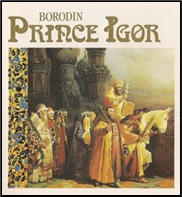
xxxxxIt was on his return from Germany that, in his spare time, Borodin joined The Mighty Five - a group dedicated to the creation of authentic Russian music - and began to take lessons from the group’s founder, the Russian composer Mily Balakirev. Progress was slow, however. Because of his commitments as a chemistry lecturer his time for composition was severely limited. He was, as he put it, a “Sunday composer”. Science was his work and music was his “fun”. As a consequence his musical output was comparatively small, but in his opera, symphonies, chamber music and his dozen or so beautiful songs, he captured the essence of his country’s folk music, together with the striking harmonies which characterize Russian folk melodies. In this he was aided by a fine sense of rhythm, and a sound knowledge of the potential of each instrument at his disposal.
xxxxxToday Borodin is mainly remembered for four works, his opera Prince Igor, his Second Symphony, his tone poem In the Steppes of Central Asia, and his Second String Quartet. His masterpiece, the opera Prince Igor, set in the 12th century and based on Russian folklore, is somewhat lacking in dramatic content, but highly charged with Slavic melody and Oriental colour. Its second Act contains the popular Polovtsian Dances. His Second Symphony, made up of material originally intended for Prince Igor, was completed in 1876, and much admired for its vibrant, exotic melodies and the bright quality of its orchestration. His mu sical tableau In the Steppes of Central Asia is a haunting work conjuring up the journey of a camel train across a vast, remote landscape. His Second String Quartet, a gentle, lyrical work, completed in 1881, is today regarded as one of Russia’s finest pieces of chamber music.
sical tableau In the Steppes of Central Asia is a haunting work conjuring up the journey of a camel train across a vast, remote landscape. His Second String Quartet, a gentle, lyrical work, completed in 1881, is today regarded as one of Russia’s finest pieces of chamber music.
xxxxxBorodin composed little from 1882 onwards, mainly due to the pressure of his research work and the onset of ill health. He died suddenly of a heart attack while attending a ball in February 1887, and was buried in Tikhvin Cemetery in St. Petersburg.
xxxxxIncidentally, during his travels to Western Europe to attend scientific conferences, Borodin met a number of leading musicians, including Franz Liszt. The Hungarian composer became a close friend and often advised him on musical matters. ……

xxxxx……xxIn 1953 the musical Kismet, based on Borodin’s music, was opened on Broadway in New York. The show’s worldwide success, together with the film version two years later, led to a revival of interest in the Russian composer’s works. ……
xxxxx……xxApart from his teaching and research at the Academy of Medicine, Borodin helped to found the School of Medicine for Women in 1872, and he gave lectures there until his death. His scientific research, notably on the properties of aldehydes and amarines, made him one of the leading chemists in Europe. ……
xxxxx……xxThrough his work as an experimental chemist, Borodin was a close friend of his fellow countryman Dmitri Mendeleev, the chemist who compiled the first version of the periodic table of elements. On one occasion they spent a holiday together in Italy.
xxxxxAs we have seen, the Russian composer Aleksandr Borodin (1833-1887) was a close friend of Nicolai Rimsky-Korsakov. He trained as a chemist and worked at the Academy of Medicine in St. Petersburg for much of his life, but he made a name for himself as a composer in his spare time. As a member of The Mighty Five, his compositions - opera, symphonies, chamber music and songs - captured the essence of his country’s folk music. His works showed a fine sense of rhythm and many were highly charged with Slavic melody and Oriental colour. His best known works are his colourful but unfinished opera Prince Igor (which Rimsky-Korsakov helped to complete); his Second Symphony, premiered in 1876; his tone poem of 1880 entitled In the Steppes of Central Asia; and his Second String Quartet, a gentle, lyrical piece completed in 1881. During his travels as a distinguished research chemist he came to know the Hungarian composer Franz Liszt, and benefited from his musical advice. In 1953 the Broadway musical Kismet, based on his music, proved a worldwide success. This, together with the film version two years later, led to a revival of interest in Borodin’s works.






 xxxxxNikolai Rimsky-
xxxxxNikolai Rimsky- xxxxxHowever, despite his naval duties, Rimsky-
xxxxxHowever, despite his naval duties, Rimsky- xxxxxIn the 1870s he composed some notable chamber music, such as his String Quartet, String Sextet and his Quintet for Piano and Winds, and the 1880s saw a number of dazzling works which have remained popular, including his Spanish Capriccio, the symphonic suite Scheherazade of 1888, (inspired by a tale from The Arabian Nights), and the Russian Easter Festival Overture, based on ancient liturgical chants of the Russian Orthodox Church. But, it was in his series of operas, beginning with May Night in 1879, that
xxxxxIn the 1870s he composed some notable chamber music, such as his String Quartet, String Sextet and his Quintet for Piano and Winds, and the 1880s saw a number of dazzling works which have remained popular, including his Spanish Capriccio, the symphonic suite Scheherazade of 1888, (inspired by a tale from The Arabian Nights), and the Russian Easter Festival Overture, based on ancient liturgical chants of the Russian Orthodox Church. But, it was in his series of operas, beginning with May Night in 1879, that  Rimsky-
Rimsky- Revolution), but two years later he produced his final opera, The Golden Cockerel, and visited Paris to conduct concerts for the Ballet Russes, a company formed and directed by the Russian ballet impresario Sergei Diaghilev. The following year, 1908, he suffered a fatal heart attack and died at his estate near Luga (now Plyusski). He was interred at the Tikhvin Cemetery in St. Petersburg, near to the graves of Borodin, Mussorgsky, and Glinka. His death brought an end to the great era of Russian music, but a new, exciting age emerged two years later when the controversial ballet Firebird, the work of the Russian revolutionary composer Igor Stravinsky, was given its first performance.
Revolution), but two years later he produced his final opera, The Golden Cockerel, and visited Paris to conduct concerts for the Ballet Russes, a company formed and directed by the Russian ballet impresario Sergei Diaghilev. The following year, 1908, he suffered a fatal heart attack and died at his estate near Luga (now Plyusski). He was interred at the Tikhvin Cemetery in St. Petersburg, near to the graves of Borodin, Mussorgsky, and Glinka. His death brought an end to the great era of Russian music, but a new, exciting age emerged two years later when the controversial ballet Firebird, the work of the Russian revolutionary composer Igor Stravinsky, was given its first performance.  xxxxxWithin the members of The Mighty Five, Rimsky-
xxxxxWithin the members of The Mighty Five, Rimsky- Xxxxx…… Nadezhda, whom Rimsky-
Xxxxx…… Nadezhda, whom Rimsky- xxxxxThexRussian pianist, composer and conductor Mily Balakirev (1837-
xxxxxThexRussian pianist, composer and conductor Mily Balakirev (1837- c. He and his fellowxmusicians were (clockwise from left) Balakirev, Rimsky-
c. He and his fellowxmusicians were (clockwise from left) Balakirev, Rimsky- xxxxxAnd worthy of mention at this time is the French pianist, organist, teacher and composer César Franck (1822-
xxxxxAnd worthy of mention at this time is the French pianist, organist, teacher and composer César Franck (1822-
 xxxxxFranck composed only twelve major organ works during his career, produced over a period of thirty years, but such were their quality that he is recognised today as one of the greatest composers of organ music since the German composer Johann Sebastian Bach. His major symphonic, chamber and keyboard works date from the late 1870s and the 1880s. They include his oratorios Redemption and Les Béatitudes, his Piano Quintet, his tone poem Le Chasseur Maudit, his Symphonic Variations, his Violin Sonata, his well-
xxxxxFranck composed only twelve major organ works during his career, produced over a period of thirty years, but such were their quality that he is recognised today as one of the greatest composers of organ music since the German composer Johann Sebastian Bach. His major symphonic, chamber and keyboard works date from the late 1870s and the 1880s. They include his oratorios Redemption and Les Béatitudes, his Piano Quintet, his tone poem Le Chasseur Maudit, his Symphonic Variations, his Violin Sonata, his well-
 xxxxxAs we have seen, the Russian composer Aleksandr Borodin (1833-
xxxxxAs we have seen, the Russian composer Aleksandr Borodin (1833-
 sical tableau In the Steppes of Central Asia is a haunting work conjuring up the journey of a camel train across a vast, remote landscape. His Second String Quartet, a gentle, lyrical work, completed in 1881, is today regarded as one of Russia’s finest pieces of chamber music.
sical tableau In the Steppes of Central Asia is a haunting work conjuring up the journey of a camel train across a vast, remote landscape. His Second String Quartet, a gentle, lyrical work, completed in 1881, is today regarded as one of Russia’s finest pieces of chamber music.


